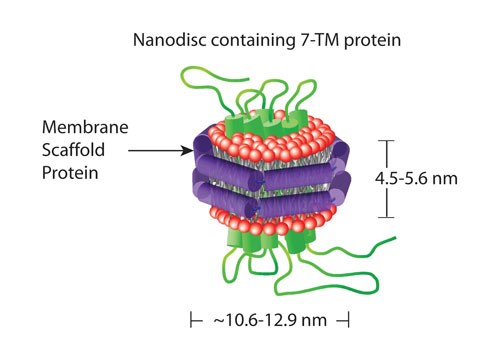Mempro™ Membrane Protein Production in Nanodisc
Creative Biostructure has established an advanced Mempro™ Nanodisc technology platform for a long time. With our experienced scientists hammered at Nanodisc technology for years, we can provide tailored Mempro™ membrane protein production in Nanodisc services.
Membrane proteins have showed a challenge to functional and biochemical researches for a long time. In the conditions without a bilayer, individual proteins and pivotal macromolecular complexes are possibly insoluble and display altered or absent activities. Nanodisc presents a great advantage for the isolation, purification, functional characterization and structural resolution of membrane proteins. Moreover, the capacity of accurately control the nanodisc composition offers a nanoscale membrane surface for investigating molecular recognition events.
Nanodisc is discoidal lipid bilayers, it can keep stabilized in aqueous solutions by two membrane scaffold proteins(MSP), which are amphipathic helical protein belts. The size of nanodisc is nearly 8–16 nm in diameter, which is determined by the length of the MSP and the lipids employed in the self-assembly process. The reconstitution of Nanodisc is controlled by the type of MSP and phospholipid input, the stoichiometry of MSP, lipid and membrane protein are important as well.
 Figure 1. Illustration of a Nanodisc containing a 7-transmembrane protein (Genetic Engineering & Biotechnology News 2012)
Figure 1. Illustration of a Nanodisc containing a 7-transmembrane protein (Genetic Engineering & Biotechnology News 2012)
- Reconstitution of Membrane Protein into Nanodisc
Nanodisc reconstitution demands considerably large numbers of membrane protein, which are used for the optimization of the nanodisc reconstitution procedure and the subsequent series of experiments. To get high return homogeneous Nanodiscs, a specific ratio of phospholipid to MSP is necessary during the assembly process based on the MSP belt-length/Nanodisc diameter. The detergent used for initial solubilization is important as well. The assembly process of Nanodisc is began by removal of detergent, the process is usually achieved by dialysis or treatment with porous polystyrene beads.
- Biophysical Characterization of Nanodisc for Membrane protein
The characterization of the nanodisc size and component stoichiometry of membrane proteins inset in a nanodisc are necessary, with special key point on the number of target membrane proteins per nanodisc. Creative Biostructure can perform biophysical characterization of Nanodisc using several approaches: small angle x-ray scattering, include size exclusion chromatography, scanning probe microscopy and electron microscopy. Besides, there are two methods for membrane proteins without chromophores which don’t need modification or labeling at all, that is DLS and AUC. DLS analyzes the fluctuations in the intensity of sporadic light, this technique is quite direct, it can both available for the quick characterization of receptor nanodiscs and nanodiscs devoid of receptors.
Creative Biostructure provides other various Mempro™ membrane proteins reconstituted in nanodisc services. Please feel free to contact us for a detailed quote.
References:
Shirzad-Wasei N, van Oostrum J, Bovee-Geurts P H M, et al. Rapid transfer of overexpressed integral membrane protein from the host membrane into soluble lipid nanodiscs without previous purification[J]. Biological chemistry, 2015, 396(8): 903-915.
Gates R. Mass Spec Analysis of Intact Membrane Proteins[J]. 2012.
Dominik P K, Borowska M T, Dalmas O, et al. Conformational chaperones for structural studies of membrane proteins using antibody phage display with nanodiscs[J]. Structure, 2016, 24(2): 300-309.
